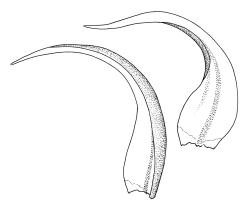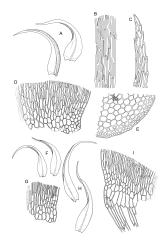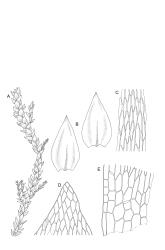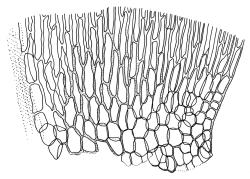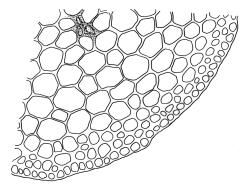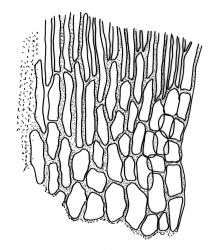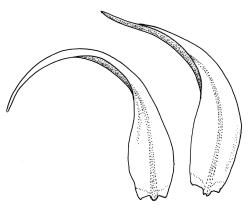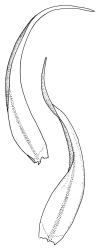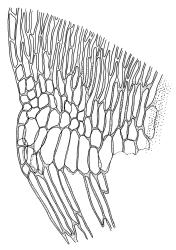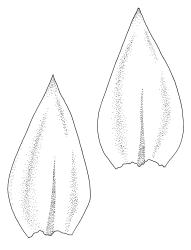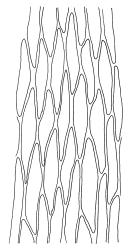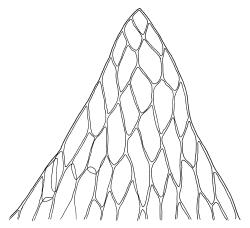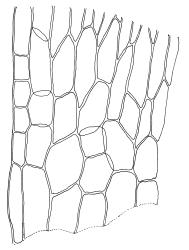- ≡ Hypnum fluitans Hedw., Sp. Musc. Frond. 296 (1801)
- ≡ Drepanocladus fluitans (Hedw.) Warnst., Beih. Bot. Centralbl. 13: 404 (1903)
Drepanocladus fontinaliopsis sensu Dixon (1929, p. 318); Sainsbury (1955, p. 427).
Calliergidium austro-stramineum sensu Bartlett (1984).
Plants medium-sized, yellow-green to dark brown-green, rarely vinaceous or straw-coloured. Stems subpinnately and radially branched, commonly from c. 20–120 mm (or longer in aquatic forms), in cross-section lacking a hyaloderm, with a distinct central strand. Leaves falcate-secund throughout or ± straight on lower stem and ± falcate-secund at tips, or rarely straight throughout, narrowly lanceolate and narrowed gradually to an acuminate apex (occasionally very slender) or rarely broadly ovate and obtuse, weakly narrowed to insertion, denticulate or rarely nearly entire near apex, concave, not or rarely weakly striolate when dry, weakly decurrent, (1.0–)2.5–3.2(–4.5) × (0.4–)0.6–0.75 mm (under cover slip); upper laminal cells linear, mostly 60–100(–120) × 5–6 µm, firm-walled, not or very weakly porose, smooth or weakly prorate, lacking or rarely with rhizoid initials; alar cells gradually differentiated and forming a medium-sized group of moderately inflated and thinner-walled cells, extending less than half-way to costal base, often with c. 6 cells more strongly inflated in the extreme angle, weakly decurrent, not or weakly auriculate, mostly pigmented but sometimes weakly so. Costa rather stout and well-defined, c. 60–70 µm wide near base, extending c. ½–¾ the leaf length, single and unbranched (rarely weak, shorter, and ± branched).
Autoicous. Perichaetia scattered and conspicuous on stems, c. 6 mm; perichaetial leaves erect, abruptly acuminate from an oblong base, sheathing the setae, weakly costate, entire, not plicate. Perigonia inconspicuous on stems, c. 1.3 mm, the leaves acuminate from a broadly elliptic base, ecostate. Setae very long, flexuose, c. 60–70 mm, red-brown, fading to straw-coloured in dried material, smooth; capsules short-cylindric, inclined to horizontal, strongly curved, c. 2.5–3 mm, with a rather short tapered neck and only weakly narrowed below the mouth when dry; mouth slightly oblique; exothecial cells nearly isodiametric to short-oblong, firm-walled and slightly thickened in corners; stomata numerous in neck, with elliptic pores. Peristome as per genus; endostomal cilia mostly in groups of 2–3, nodose. Spores 21–27 µm diam., papillose.
Kanda 1976, figs. 35–36 (as Drepanocladus fluitans); Crum & Anderson 1981, fig. 470 (as D. fluitans); Scott & Stone 1976, pl. 82 (as D. fluitans).
Warnstorfia fluitans is sometimes confused with species of Drepanocladus s.s., particularly D. brachiatus which is autoicous. Features which facilitate the separation of these taxa are discussed under Drepanocladus. Some collections of W. fluitans can also be difficult to differentiate from Scorpidium cossonii; the absence of a hyaloderm in W. fluitans helps in such instances. Warnstorfia fluitans differs from W. exannulata (a species not reliably recorded from N.Z.) by being autoicous, by having an alar group that is smaller, more weakly differentiated, and composed of less inflated cells, by lacking denticulations on the lower leaf margins, and by lacking a stem hyaloderm.
NI: N Auckland (Tōwai), S Auckland, Gisborne (Hikurangi, Lake Waikareiti), Taranaki (Mt Egmont), Wellington; SI: Nelson, Marlborough (Pelorus Bridge, otherwise poorly documented), Canterbury, Westland, Otago, Southland; St; Ch; A; Ant; C; M.
Nearly cosmopolitan. Tasmania* and recorded from three states and A.C.T. on mainland Australia by Scott & Stone (1976). Hedenäs (2003) described the world distribution of this widespread species as "widespread mainly in arctic to temperate North America and Eurasia, as well as in North and Central Africa, New Guinea, Australia, and New Zealand." Hedenäs (2003) also recorded it from southern South America, the Falkland Is., and high altitude sites in tropical South America.
Growing in a wide range of subaquatic and aquatic habitats, including lake margins, roadside ditches, slow-moving streams, intermittent pools and waterlogged muck in swamps and bogs, grassland tarns, damp hollows in both forest and open areas (including farm paddocks and pākihi). Often forming extensive and mostly pure floating mats in still, shallow waters and mostly occurring in nutrient-poor and acid situations. Ranging from near sea level to c. 1580 m (Arthur Range, Nelson L.D.). Sphagnum falcatulum is the most frequently co-occurring moss species.
In its most common expression of yellow- to brown-green plants with subpinnately branching and narrow, falcate-secund, and distinctly denticulate leaves, W. fluitans is easily recognised. The habit drawing in Scott & Stone (1976, pl. 82, as Drepanocladus fluitans) gives an excellent impression of representative plants of this species. However, W. fluitans is disturbingly variable in N.Z., as in other parts of its range. In N.Z. considerable variability occurs in the degree of alar cell differentiation, costal strength, plant size, leaf orientation, shape, and spacing, and cellular pigmentation. As a consequence non-representative material can be difficult to name with confidence.
In the bulk of material the denticulations of the upper leaf margins are quite obvious under a compound scope, but in occasional populations the denticulations can be inconspicuous or restricted to the extreme apex of the leaf. Very poorly developed material (from Cape Foulwind, Nelson L.D.) in which the leaves are broadly ovate, obtuse, and lack apical denticulations was reported by Bartlett (1984) as Calliergidium austro-stramineum (Müll.Hal.) E.B.Bartram. Material on which Bartlett’s record was based is illustrated in Image: Image\1IH7 (as W. fluitans "calliergidium" growth form) and discussed above under "excluded taxa".
Much variation can occur within a single population or collection, particularly in floating plants subject to water-level fluctuations and no useful purpose is served by attempting to segregate extreme forms. This broad view of W. fluitans is comparable with those presented in several modern revisions/floristic treatments (e.g., Kanda 1977; Crum & Anderson 1981 (both as Drepanocladus fluitans); Smith 2004).
Some N.Z. material, mostly from the Rotorua area, has been referred to Drepanocladus fontinaliopsis (Müll.Hal.) Dixon (Dixon 1929, p. 318) or to D. fluitans var. berggrenii (Ochyra & Bartlett 1986). The latter authors placed D. fontinaliopsis (which has a Kerguelen type) in the synonymy of the European-based D. fluitans var. berggrenii (C.E.O.Jensen) C.E.O.Jensen. Drepanocladus fontinaliopsis was again discussed (and accepted as a species in Warnstorfia) by Ochyra et al. (2008).
N.Z. records of Drepanocladus fontinaliopsis were based initially on collections made by S. Berggren in 1874. Berggren 2577 (CHR 580343; WELT M004879) is a slender from of W. fluitans with leaves straight, ± erect, and sharply denticulate, and the costa poorly defined and short (c. ¼ the leaf). This and another Berggren collection (unavailable for study) was cited by Dixon (1929, p. 318). A suite of morphologically similar collections, mostly from Lake Rotorua, has been examined. This suite includes K.W. Allison 437 (CHR 580344, WELT M004880) and 2728 (CHR 585923). In my opinion this material falls within the range of continuous variation of W. fluitans. Neither Drepanocladus fontinaliopsis nor D. fluitans var. berggrenii are considered further here.



